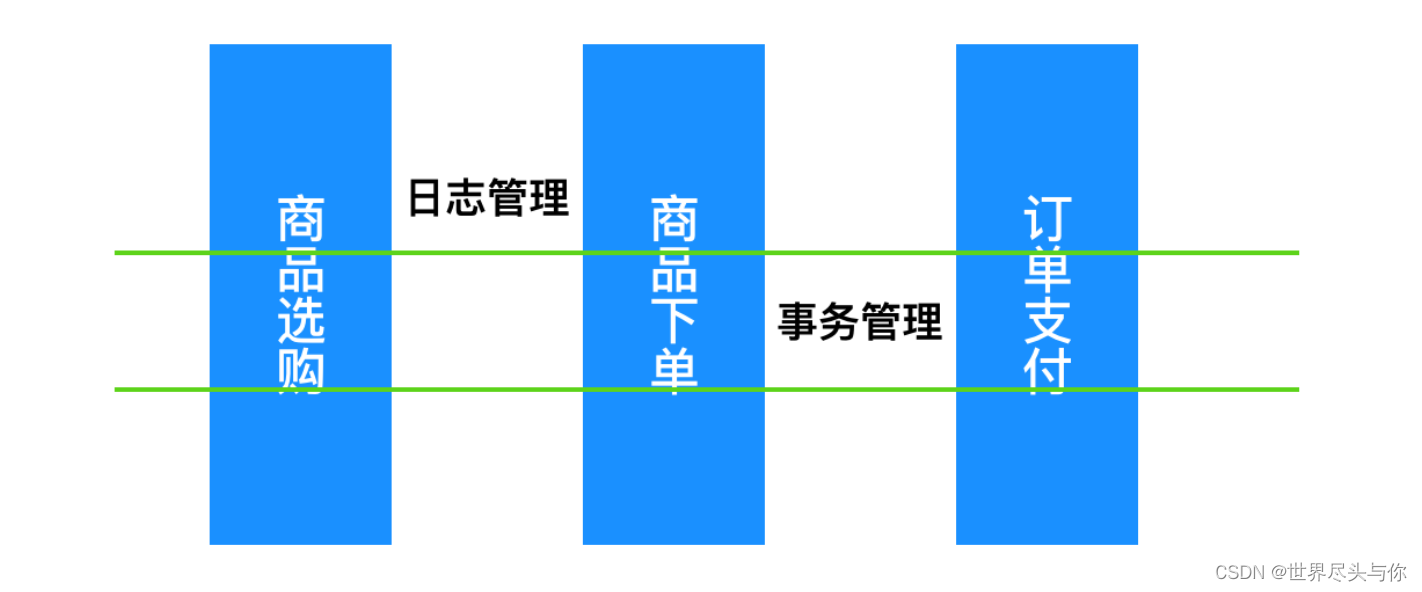-
一文详解 Spring AOP
1.关于AOP
面向切面编程(俗称AOP)提供了一种面向对象编程(俗称OOP)的补充,面向对象编程最核心的单元是类(class),然而面向切面编程最核心的单元是切面(Aspects)。与面向对象的顺序流程不同,AOP采用的是横向切面的方式,注入与主业务流程无关的功能,例如事务管理和日志管理。
图示:

Spring的一个关键组件是AOP框架。 虽然Spring IoC容器不依赖于AOP(意味着你不需要在IOC中依赖AOP),但AOP为Spring IoC提供了非常强大的中间件解决方案。
AOP 是一种编程范式,最早由 AOP 联盟的组织提出的,通过预编译方式和运行期动态代理实现程序功能的统一维护的一种技术。它是 OOP的延续。利用 AOP 可以对业务逻辑的各个部分进行隔离,从而使得业务逻辑各部分之间的耦合度降低,提高程序的可重用性,同时提高了开发的效率
2.初步使用AOP环境配置
要使用Spring AOP,需要导入如下的maven包:
<dependency> <groupId>org.springframeworkgroupId> <artifactId>spring-webmvcartifactId> <version>5.3.23version> dependency> <dependency> <groupId>org.aspectjgroupId> <artifactId>aspectjweaverartifactId> <version>1.9.9.1version> dependency>- 1
- 2
- 3
- 4
- 5
- 6
- 7
- 8
- 9
- 10
- 11
- 12
在对应的Spring配置文件中,需要导入aop的约束:
xmlns:aop="http://www.springframework.org/schema/aop"- 1
xsi:schemaLocation="http://www.springframework.org/schema/beans http://www.springframework.org/schema/beans/spring-beans.xsd http://www.springframework.org/schema/aop http://www.springframework.org/schema/aop/spring-aop.xsd"- 1
- 2
- 3
- 4
整体的配置如下:
<beans xmlns="http://www.springframework.org/schema/beans" xmlns:xsi="http://www.w3.org/2001/XMLSchema-instance" xmlns:aop="http://www.springframework.org/schema/aop" xsi:schemaLocation="http://www.springframework.org/schema/beans http://www.springframework.org/schema/beans/spring-beans.xsd http://www.springframework.org/schema/aop http://www.springframework.org/schema/aop/spring-aop.xsd"> beans>- 1
- 2
- 3
- 4
- 5
- 6
- 7
- 8
- 9
- 10
编写接口类:UserService.java
public interface UserService { public void add(); public void delete(); public void update(); public void query(); }- 1
- 2
- 3
- 4
- 5
- 6
接口实现类:UserServiceImpl.java
public class UserServiceImpl implements UserService { @Override public void add() { System.out.println("增加用户"); } @Override public void delete() { System.out.println("删除用户"); } @Override public void update() { System.out.println("更新用户"); } @Override public void query() { System.out.println("查找用户"); } }- 1
- 2
- 3
- 4
- 5
- 6
- 7
- 8
- 9
- 10
- 11
- 12
- 13
- 14
- 15
- 16
- 17
- 18
- 19
- 20
- 21
- 22
待插入的前置日志类:Log.java
/** * 插入的前置日志类 */ public class Log implements MethodBeforeAdvice { @Override public void before(Method method, Object[] args, Object target) throws Throwable { System.out.println(target.getClass().getName() + "的" + method.getName() + "被执行了!"); } }- 1
- 2
- 3
- 4
- 5
- 6
- 7
- 8
- 9
待插入的后置日志类:AfterLog.java
/** * 插入的后置日志类 */ public class AfterLog implements AfterReturningAdvice { @Override public void afterReturning(Object returnValue, Method method, Object[] args, Object target) throws Throwable { System.out.println("执行了" + method.getName() + "方法,返回结果为:" + returnValue); } }- 1
- 2
- 3
- 4
- 5
- 6
- 7
- 8
- 9
注册类的bean标签:
<bean id="userService" class="top.imustctf.service.UserServiceImpl"/> <bean id="log" class="top.imustctf.log.Log"/> <bean id="afterLog" class="top.imustctf.log.AfterLog"/>- 1
- 2
- 3
- 4
3.使用原生Spring API接口实现AOP
配置aop:
切入点是待切入的方法,使用正则表达式匹配
执行环绕增加是具体向切入点添加日志的配置
<aop:config> <aop:pointcut id="pointcut" expression="execution(* top.imustctf.service.UserServiceImpl.*(..))"/> <aop:advisor advice-ref="log" pointcut-ref="pointcut"/> <aop:advisor advice-ref="afterLog" pointcut-ref="pointcut"/> aop:config>- 1
- 2
- 3
- 4
- 5
- 6
- 7
- 8
现在来测试一下吧:
可以看到,AOP动态代理切入成功了!
@Test public void test() { ClassPathXmlApplicationContext context = new ClassPathXmlApplicationContext("applicationContext.xml"); UserService userService = context.getBean("userService", UserService.class); userService.add(); // top.imustctf.service.UserServiceImpl的add被执行了! // 增加用户 // 执行了add方法,返回结果为:null }- 1
- 2
- 3
- 4
- 5
- 6
- 7
- 8
- 9
4.使用自定义类实现AOP
先Diy一个切面类:DiyPointCut.java
public class DiyPointCut { public void before() { System.out.println("方法执行前"); } public void after() { System.out.println("方法执行后"); } }- 1
- 2
- 3
- 4
- 5
- 6
- 7
- 8
- 9
注册diy类并配置切面:
<bean id="diy" class="top.imustctf.diy.DiyPointCut"/> <aop:config> <aop:aspect ref="diy"> <aop:pointcut id="point" expression="execution(* top.imustctf.service.UserServiceImpl.*(..))"/> <aop:before method="before" pointcut-ref="point"/> <aop:after method="after" pointcut-ref="point"/> aop:aspect> aop:config>- 1
- 2
- 3
- 4
- 5
- 6
- 7
- 8
- 9
- 10
- 11
来开始测试:
@Test public void test() { ClassPathXmlApplicationContext context = new ClassPathXmlApplicationContext("applicationContext.xml"); UserService userService = context.getBean("userService", UserService.class); userService.add(); // 方法执行前 // 增加用户 // 方法执行后 }- 1
- 2
- 3
- 4
- 5
- 6
- 7
- 8
- 9
5.使用注解实现AOP
使用注解实现AOP,它更简单,更强大!
在使用注解开发前,需要在Spring配置文件中开启动态代理的支持:
<aop:aspectj-autoproxy/>- 1
接下来,使用注解直接开发AOP类:
@Component @Aspect // 标注这个类是一个切面 public class AnnotationPointCut { @Before("execution(* top.imustctf.service.UserServiceImpl.*(..))") public void before() { System.out.println("方法执行前啊!"); } @After("execution(* top.imustctf.service.UserServiceImpl.*(..))") public void after() { System.out.println("方法执行后啊!"); } }- 1
- 2
- 3
- 4
- 5
- 6
- 7
- 8
- 9
- 10
- 11
- 12
- 13
现在来测试一下吧:
@Test public void test() { ClassPathXmlApplicationContext context = new ClassPathXmlApplicationContext("applicationContext.xml"); UserService userService = context.getBean("userService", UserService.class); userService.add(); // 方法执行前啊! // 增加用户 // 方法执行后啊! }- 1
- 2
- 3
- 4
- 5
- 6
- 7
- 8
- 9
-
相关阅读:
CISSP学习笔记:灾难恢复计划
Revit中顶对齐风管的绘制及“管线自动对齐”功能
【前端系列】前端如何使用websocket发送消息
Java开发中List数据量大,需要分片批次处理
01准备阶段 Latex相关软件安装
idea全局搜索快捷键总结
STM32HAL-完全解耦面向对象思维的架构-时间轮片法使用(timeslice)
ITE IT66021FN/BX HDMI 1.4接收器/接收芯片/收发器
OpenHarmony网络协议通信—kcp
Java8 Streams用法总结大全 之 Collector用法详解
- 原文地址:https://blog.csdn.net/Gherbirthday0916/article/details/127734628